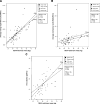Energy expenditure and physical activity in Prader-Willi syndrome: comparison with obese subjects
- PMID: 17103434
- PMCID: PMC5459598
- DOI: 10.1002/ajmg.a.31507
Energy expenditure and physical activity in Prader-Willi syndrome: comparison with obese subjects
Abstract
Prader-Willi syndrome (PWS) is a complex neurodevelopmental disorder characterized by hypotonia, suck and feeding difficulties, hypogonadism, small hands and feet, developmental delay, hyperphagia and early childhood obesity and a particular facial appearance. The obesity associated with PWS is the result of a chronic imbalance between energy intake and energy expenditure (EE) due to hyperphagia, decreased physical activity, reduced metabolic rate and an inability to vomit. EE is affected by body composition as well as exercise. Individuals with PWS have a lower lean body mass (LBM) compared with controls which may contribute to reduced basal level EE. To determine the relationship among body composition, activity levels and metabolic rates, dual energy X-ray absorptiometry (DEXA) and a whole-room respiration chamber were used to measure body composition, total EE (TEE), resting EE (REE), physical activity, and mechanical work (MW) during an 8 hr monitoring period. The chamber consisted of a live-in whole-room indirect calorimeter equipped with a force platform floor to allow simultaneous measurement of EE, physical activity, and work efficiency during spontaneous activities and standardized exercise. Participants with PWS (27 with 15q11-q13 deletion and 21 with maternal disomy 15 with an average age of 23 years) had significantly decreased TEE by 20% and reduced LBM compared to 24 obese subjects. Similarly, REE was significantly reduced by 16% in the individuals with PWS relative to the comparison subjects. Total MW performed during the 8 hr monitoring period was significantly reduced by 35% in the PWS group. The energy cost of physical activity is related to the duration, intensity and type of activity and the metabolic efficiency of the individual. After adjusting group differences in LBM by analysis of variance, TEE and REE were no longer different between the two groups. Our data indicate that there is a significant reduction of EE in individuals with PWS resulting from reduced activity but also from lower energy utilization due to reduced LBM which consists primarily of muscle.
(c) 2006 Wiley-Liss, Inc.
Figures





Similar articles
-
Development and validation of a measurement system for assessment of energy expenditure and physical activity in Prader-Willi syndrome.Obes Res. 1999 Jul;7(4):387-94. doi: 10.1002/j.1550-8528.1999.tb00422.x. Obes Res. 1999. PMID: 10440595 Free PMC article.
-
Measured Resting Energy Expenditure by Indirect Calorimetry and Energy Intake in Long-Term Growth Hormone-Treated Children with PWS.Horm Res Paediatr. 2025;98(2):164-173. doi: 10.1159/000536466. Epub 2024 Feb 16. Horm Res Paediatr. 2025. PMID: 38368858 Free PMC article.
-
Insulin resistance and obesity-related factors in Prader-Willi syndrome: comparison with obese subjects.Clin Genet. 2005 Mar;67(3):230-9. doi: 10.1111/j.1399-0004.2004.00392.x. Clin Genet. 2005. PMID: 15691361 Free PMC article.
-
Prader-Willi Syndrome - Clinical Genetics, Diagnosis and Treatment Approaches: An Update.Curr Pediatr Rev. 2019;15(4):207-244. doi: 10.2174/1573396315666190716120925. Curr Pediatr Rev. 2019. PMID: 31333129 Free PMC article. Review.
-
Prader-Willi syndrome: a review of clinical, genetic, and endocrine findings.J Endocrinol Invest. 2015 Dec;38(12):1249-63. doi: 10.1007/s40618-015-0312-9. Epub 2015 Jun 11. J Endocrinol Invest. 2015. PMID: 26062517 Free PMC article. Review.
Cited by
-
Missed Diagnoses and Health Problems in Adults With Prader-Willi Syndrome: Recommendations for Screening and Treatment.J Clin Endocrinol Metab. 2020 Dec 1;105(12):e4671-87. doi: 10.1210/clinem/dgaa621. J Clin Endocrinol Metab. 2020. PMID: 32877518 Free PMC article.
-
Higher plasma orexin a levels in children with Prader-Willi syndrome compared with healthy unrelated sibling controls.Am J Med Genet A. 2016 Sep;170(9):2328-33. doi: 10.1002/ajmg.a.37777. Am J Med Genet A. 2016. PMID: 27518917 Free PMC article.
-
Effects of COVID-19 Lockdown on Weight, Body Composition, and Behavior of Children, Adolescents, and Young Adults with Prader-Willi Syndrome.J Clin Med. 2021 Oct 16;10(20):4746. doi: 10.3390/jcm10204746. J Clin Med. 2021. PMID: 34682869 Free PMC article.
-
Prader-Willi syndrome: A primer for clinicians.Int J Pediatr Endocrinol. 2011 Oct 18;2011(1):12. doi: 10.1186/1687-9856-2011-12. Int J Pediatr Endocrinol. 2011. PMID: 22008714 Free PMC article.
-
Body composition, adipokines, bone mineral density and bone remodeling markers in relation to IGF-1 levels in adults with Prader-Willi syndrome.Int J Pediatr Endocrinol. 2018;2018:1. doi: 10.1186/s13633-018-0055-4. Epub 2018 Jan 16. Int J Pediatr Endocrinol. 2018. PMID: 29371863 Free PMC article.
References
-
- Abbott WG, Howard BV, Ruotolo G, Ravussin E. Energy expenditure in humans: Effects of dietary fat and carbohydrate. Am J Physiol. 1990;258:E347–E351. - PubMed
-
- Bekx MT, Carrel AL, Shriver TC, Li Z, Allen DB. Decreased EE is caused by abnormal body composition in infants with Prader-Willi Syndrome. J Pediatr. 2003;143:372–376. - PubMed
Publication types
MeSH terms
Grants and funding
LinkOut - more resources
Full Text Sources
Other Literature Sources
Medical
Molecular Biology Databases

